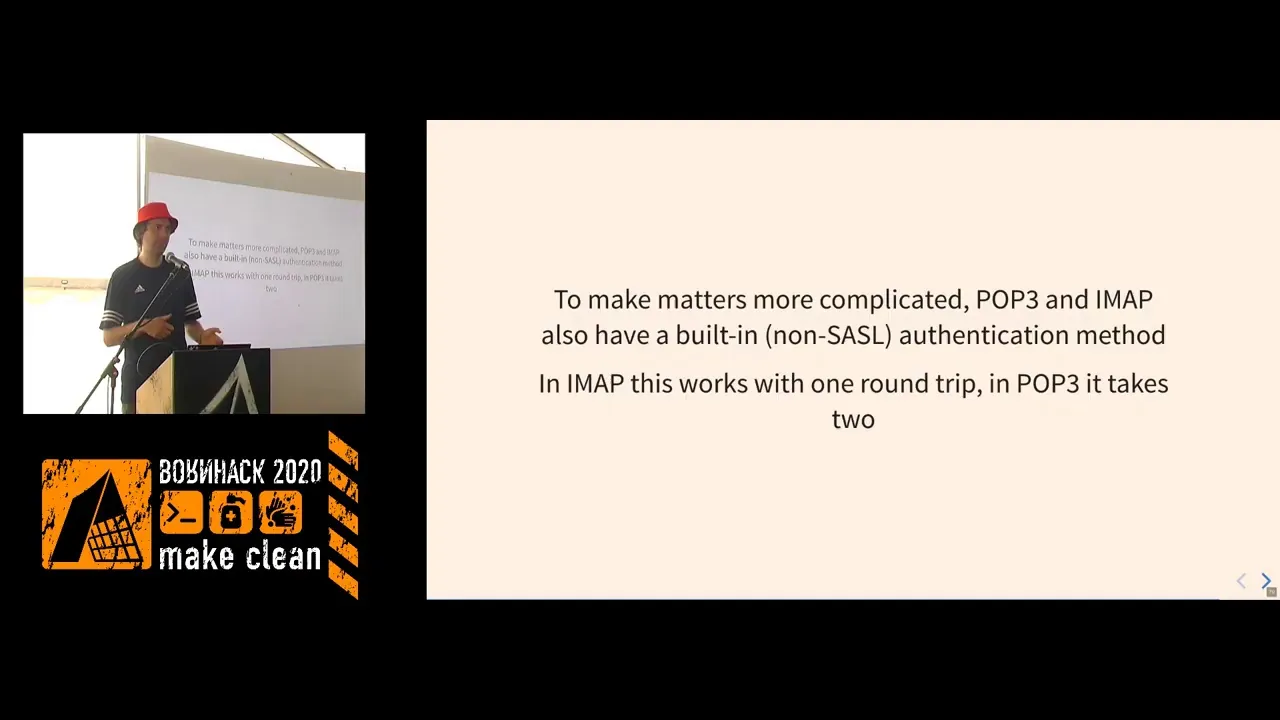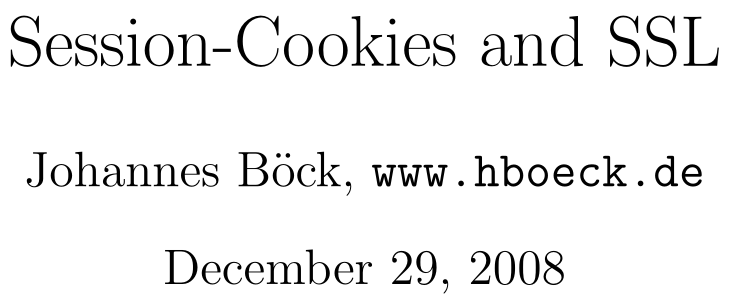Bypassing HTTP Strict Transport Security (HSTS)
Hanno Böck
Once there was HTTP without encryption
In 1995, Netscape introduced SSL - today known as TLS - and HTTPS
SSL and HTTPS
- Encryption
- Integrity
- Authentication
SSL and HTTPS
- Expensive
- Optional security
- Mixing secure and insecure contexts
Mixing secure and insecure contexts
Mixing secure and insecure contexts isn't just a problem with HTTP; it's also a problem with e-mail protocols
https://nostarttls.secvuln.info/ |
 https://youtu.be/kgR1nQYWBM8 |
Today, we want to talk about mixing insecure HTTP with secure HTTPS
Cookies
Cookies are bound to the hostname (e.g., www.example.com) or the whole domain (e.g., .example.com)
Cookies
Set Cookie over HTTPS
Read Cookie over HTTP
Cookie Secure Flag
RFC 2109, 1997
Optional. The Secure attribute (with no value) directs the user
agent to use only (unspecified) secure means to contact the origin
server whenever it sends back this cookie.
The user agent (possibly under the user's control) may determine
what level of security it considers appropriate for "secure"
cookies. [...]
RFC 6265, 2011
The Secure attribute limits the scope of the cookie to "secure" channels (where "secure" is defined by the user agent). When a cookie has the Secure attribute, the user agent will include the cookie in an HTTP request only if the request is transmitted over a secure channel (typically HTTP over Transport Layer Security (TLS) [RFC2818]).
RFC 6265, 2011, continued
Although seemingly useful for protecting cookies from active network attackers, the Secure attribute protects only the cookie's confidentiality. An active network attacker can overwrite Secure cookies from an insecure channel, disrupting their integrity [...]
A fix for that problem was only provided very recently
__Host- / __Secure- prefix
Still just a draft, but use them!
Just because we have a Secure flag for cookies does not mean people will use it
Found and reported problems in various PHP web apps and described a practical attack on eBay
Firesheep (2010)
Plugin that made Cookie stealing attacks easy
Other Cookie Security features (not TLS related)
- HttpOnly
- SameSite=Lax/Strict/None
This is how your Cookies should look like
Set-Cookie: __Host-SESSID=c60fu856m8u25vrv; path=/; Secure; HttpOnly; SameSite=Lax
Cookies are not the only problem of mixing secure HTTPS and insecure HTTP
Redirects
Let's say you want to have a very secure website, so you redirect all HTTP calls to HTTPS
HTTP/1.1 301 Moved Permanently
Location: https://hboeck.de/
The redirect is still HTTP and is not protected!
SSL Stripping
Moxie Marlinspike, 2009
A network attacker can prevent the redirect and serve a fake webpage over HTTP
Speaking of Redirects...
I see something like this quite often:
- https://example.com/ redirects to http://www.example.com/
- http://www.example.com/ redirects to https://www.example.com/
https -> http -> https
Don't do that!
How can we fix SSL Stripping?
HTTP Strict Transport Security (HSTS)
RFC 6797, 2012
Strict-Transport-Security: max-age=31536000; includeSubDomains; preload
max-age=31536000
HSTS Expires!
How do you set the time on your computers?
Network Time Protocol (NTP)
NTP is insecure by default and had no TLS support until 2020
Delorean attack on HSTS
_._
_.-="_- _
_.-=" _- | ||"""""""---._______ __..
___.===""""-.______-,,,,,,,,,,,,`-''----" """"" """"" __'
__.--"" __ ,' o \ __ [__|
__-""=======.--"" ""--.=================================.--"" ""--.=======:
] [w] : / \ : |========================| : / \ : [w] :
V___________:| |: |========================| :| |: _-"
V__________: \ / :_|=======================/_____: \ / :__-"
-----------' ""____"" `-------------------------------' ""____""
Luckily, we have Network Time Security (NTS) now
RFC 8915, 2020
Optional, usually not enabled by default, enable it!
HSTS is Trust-on-First-Use
First connection problem
preload
HSTS preload list
- ~140.000 entries
- 15 Megabyte uncompressed
- 1 Megabyte compressed
includeSubDomains
Hanno in late 2023:
How exactly does the includeSubDomains flag in HSTS work?I tried a few things
Assume the following
- https://example.com/ sets an HSTS policy with includeSubDomains
- https://sub.example.com/ sets an HSTS policy without includeSubDomains
- Which policy applies to sub.sub.example.com?
- Can you open http://sub.sub.example.com/?
- RFC says No
- Chrome blocks it
- Firefox before version 122 opens it
In Firefox before 122, any subdomain with an HSTS policy without includeSubDomain disables HSTS for all sub-sub-domains.
This even works with preloading!
Mozilla developers immediately agreed that this is a vulnerability and needs to be fixed
CVE-2024-0753
Fixed in Firefox 122
wget also affected
(fixed in 1.24.5, low impact)
Why is this a problem?
Imagine the following:
- https://example.com/ uses HSTS, includeSubDomains, *AND* preloading
- https://example.com/ sets a Cookie for .example.com without the "Secure" flag. (HSTS already makes sure it's secure!)
- https://sub.example.com/ uses HSTS without includeSubDomains
Attack!
- Attacker sends user to https://sub.example.com/ without includeSubDomains policy
- Attacker sends user to http://sub.sub.example.com/ - Cookie is transmitted in plain text
netflix.com has all the conditions for this attack to work
Have I reported this to Netflix?
No
Contact: https://bugcrowd.com/netflix Policy: https://bugcrowd.com/netflix Hiring: https://jobs.netflix.com/ Acknowledgments: https://bugcrowd.com/netflix/hall-of-fame Expires: 2025-01-01T06:00:00.000Z
Bugbounty as the only security contact is a problem
- Bugbounty triagers are trained to reject as much as possible (sad, but true)
- Technically, this is not a vulnerability on netflix.com, "just" a non-ideal configuration
https://bugcrowd.com/netflix
Please note: This program or engagement does not allow disclosure.
In preparation for this talk, I wanted to create a demo
I tried the demo in Firefox 121 (vulnerable), it worked as expected.
I tried the demo in Firefox 122 (fixed), it still worked 🤔
That was unexpected
As an attacker, how can you make sure a user opens another webpage?
Iframes!
Firefox does not let subresources set HSTS policies...
This was an attempt to fix another bug that is also undermining HSTS...
... and it did not even fix it.
https://bugzilla.mozilla.org/show_bug.cgi?id=1701192
https://bugzilla.mozilla.org/show_bug.cgi?id=1818984
Even before that, Firefox used partitioning for HSTS on subresources (similar to Cookies)
HSTS is a good feature, and you should use it, but its implementation is not necessarily robust, particularly in Firefox
Demo time!
Recommendations for Web Developers
Use HSTS and always set includeSubDomains
Use HSTS preloading for important domains
Even with HSTS, use other tools to prevent plaintext leakage
Redirects
Always redirect from http:// to https://
If your main webpage is on the www subdomain
- First redirect from http://example.com/ to https://example.com/
- Then from https://example.com/ to https://www.example.com/
This makes sure you protect all subdomains.
Avoid insecure redirects
No https:// -> http:// -> https://
Cookies
Should always have the "Secure" flag, HSTS is no excuse for not having it
Use __Host- prefix if possible, __Secure- prefix otherwise
Recommendation for Users
Enable HTTPS only mode in your browser
Thanks for listening!
Any questions?
Need help with HTTPS, HSTS, TLS?
Contact me:
https://itsec.hboeck.de/
